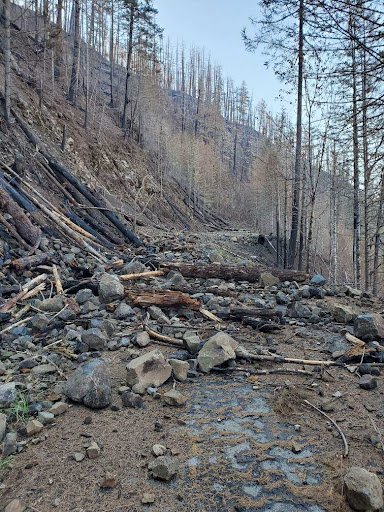May 2022 Science Corner | “Climate change increases risk of extreme rainfall following wildfire in the western United States”


In a recent paper, researchers at the Bren School of Environmental Science and Management, led by Dr. Danielle Touma who is now at the National Center for Atmospheric Research, used climate models to calculate the future risk of extreme fire followed closely by intense rainfall in the Western United States.
Authors: Danielle Touma, Samantha Stevenson, Daniel L. Swain, Deepti Singh, Dmitri A. Kalashnikov, Xingying Huang
Interview and Story By: Clare Loughlin, Communications Associate
Extreme weather events pose a severe risk to public health, infrastructure, and the environment. Climate change is increasing the frequency and intensity of these events and the likelihood that multiple events will overlap. Compounded events such as heavy rainfall in areas recently scarred by severe wildfires are increasingly common and can generate great tragedy.
Soon after the catastrophic 2018 Thomas Fire in Southern California, heavy precipitation led to a series of mudflows known as the Montecito mudslides. As a result, 23 people died, and property damages totaled $200 million. This disaster is not an isolated incident, with similar compounded impacts in 2021 in Waldo Canyon, Colorado, and Glenwood Canyon, Colorado.
Intense wildfire and rainfall independently create the conditions for debris flows. Severe wildfire can modify soil structure and chemistry (at times making soil water-repellent) and leave land vulnerable to erosion, debris flows, and mudslides. Heavy rainfall can lead to flash floods and mudslides. To make things worse, climate change is closing the conventional gap between the fire and rainy seasons in the Western United States, increasing the likelihood of overlapping extreme weather events. Recently burned areas need time to recover before the rainy season to reduce their susceptibility to becoming debris flows.
In a recent paper, researchers at the Bren School of Environmental Science and Management, led by Dr. Danielle Touma who is now at the National Center for Atmospheric Research, used climate models to calculate the future risk of extreme fire followed closely by intense rainfall in the Western United States. Using a high-warming scenario climate model experiment, Dr. Touma calculated a large increase in heavy precipitation in recently burned areas in the Western US and found regional differences in the frequency of extreme fire or extreme rain, possibly due to changes in pressure and wind patterns. Notably, Dr. Touma identified a diagonal axis from the Pacific Northwest to Colorado with the largest projected increases in post-fire extreme rainfall events.
How can we prepare for this increased risk? According to Dr. Touma, “People are exhausted from evacuating. For example, in the Thomas Fire, the Montecito mudslides were so deadly because the storm happened late at night with limited advanced warning. More resources are needed to improve evacuation communications, support climate adaptation and forest restoration, and reduce debris build-up.” Communicating the dangers of post-fire extreme rainfall, the need for evacuations, and the risks of living and developing in wildland-urban interfaces is critical.
Reintroducing healthy fire to the landscape is another way to mitigate risk. When asked if prescribed burning leaves land as vulnerable to extreme rainfall as severe wildfire, Dr. Touma replied, “Low-interval burns are a natural, important part of a resilient forest required for fire-dependent species and other ecosystem benefits.”
Unfortunately, these kinds of forest restoration treatments aren’t happening at the pace and scale needed to bring our landscapes into a more resilient state. With new approaches like conservation finance, hopefully we can accelerate the pace and scale of forest restoration and invest in wood products infrastructure to both reduce the risk of severe fires in the first place and remove potential debris from the landscape.